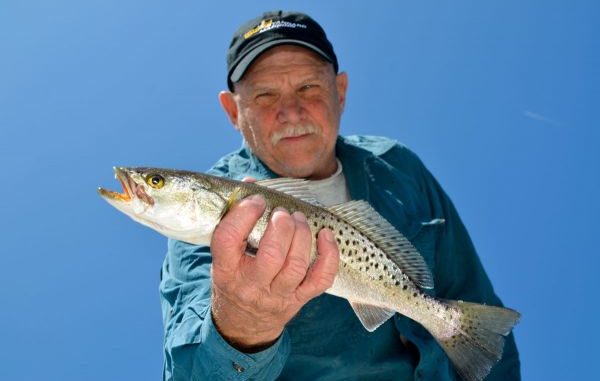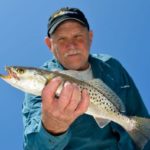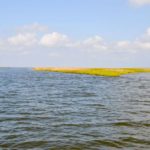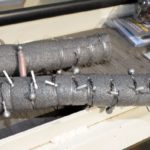
Think you can’t catch trout when during the coldest month of the year? Well, you have to go to catch them, and these digital maps can help you get to just the right spot.
Have no doubt, February is a tough time for speckled trout fishermen.
I was kind of hoping that Glenn Schurr was going to have some good news for me when we rendezvoused at Delacroix in St. Bernard Parish.
“Most people are saying there are no trout to be had right now,” Schurr rumbled with a gravelly voice dripping with an old-time New Orleans accent.
I must have looked crest-fallen, because he quickly added some encouragement.
“We’re gonna get them,” he assured me. “We’re not going out there to burn gas.”
His blue eyes twinkled and the ends of his mouth turned up in a smile beneath his sandy-grizzly moustache.
“My mapping system will put you on the exact spot you want to be after you have polled your friends for the latest information,” Schurr said. “I got advance ‘intel’ that the trout are biting at the Polk and Dallas area.”
The night before the trip, Schurr had used a pen to mark up one of his laminated maps with the spots he wanted to hit. In the boat shed across the road from his camp the next morning, he showed me how things were going to work.
He browsed the touch screen of his boat’s GPS receiver until he found the point he planned to fish and zoomed in on it. The scene on the screen was exactly the same as what appeared on his laminated map, but the zoom feature allowed for far more-exact viewing.
He chose his route and the unit created waypoints.
“Having route options was important,” Schurr explained, “because a small flat boat can go in shallow water where a deep-V boat can’t.”
Schurr and Ralph “Junior” Burst, his fishing partner and employee, took their time loading the boat for the trip. It was cold, so there was no reason to get on the water early.
On the ride out from Delacroix, Schurr explained that E-card maps are time savers.
“Instead of running around looking for landmarks, I can just cut right across open areas, always keeping an eye on depth readings to avoid shallows,” he said. “Everything looks the same out here.
“You still have to use caution, though. No map or chart shows poles or pilings.”
He looked at me with a wicked grin.
“Of course, there are no trout to be had out there now,” Schurr said.
First stop was a lake called Skippy. I quickly picked up on a couple of tackle tips from the 66-year-old veteran. Burst fished with tandem jigheads, gear that is hard to store without creating snarls.
Before the trip, Schurr wrapped pre-made tandem rigs on a piece of foam pipe insulator, stabbing the jigheads into the foam as he wrapped them. When he got to the top of the rig, he pegged its swivel into the foam with a coffee stir stick — slick as a whistle.
The other thing he did was store the soft-plastic lures he uses to tip his jigheads in empty sports drink bottles: There are no loose baits and opened bags all over his boat console.
The lures don’t fall out on their own, but can easily be shaken out of the bottles, and the plastic in the bottles and lures do not interact and melt.
Burst geared up with a tandem rig under a rattling cork. One jighead was tipped with a tuxedo H&H Cocahoe Minnow and the other held a shrimp creole Matrix Shad.
Schurr threw a single-rig jighead with a shrimp creole Matrix Shad set 2 feet below his cork.
When not forced to throw into the wind, his cork of choice was a Grande Cigar Boat Monkey Float. When the wind acted up, he changed to an old-fashioned scoop-faced popping cork, which was heavier.
Schurr swapped corks several times during the day.
The first stop didn’t produce a bump, so he cranked up and ran to our primary destination: Polk and Dallas Bayou.
As we approached the bayous, it was obvious that a boat had beaten us to what looked like the perfect spot. To be courteous, Schurr pulled his boat around the point and spudded down his double Power-Poles.
The two anglers began picking up a smattering of 11- to 14-inch speckled trout — nothing to brag about, but they were specks.
Then, for some reason, the other boat left. Schurr picked up and trolled to the spot, a point sticking into Black Bay by the northern bank of Polk and Dallas Bayou.
The fun began immediately. They started reeling in 15-inch specks.
Schurr looked over his shoulder mischievously while he unhooked a fish.
“There are no trout out here to be caught — you can’t catch trout this time of year,” he growled.
Burst was doing well, sometimes bringing in doubles on his tandem rig, but for the moment Schurr was really putting it on him.
Every cast seemed to score, and in typical South Louisiana fashion he really ragged Burst.
“You going to help me out here —catch some fish here?”
Schurr didn’t let up.
The younger man was naturally shy, and didn’t sass Schurr back. Of course, Schurr was his boss as well as a fishing partner.
But, finally, Burst answered obliquely, looking at me.
“This is a rare occasion. He better suck it up,” he said. “You know the old saying: ‘Even a blind squirrel can find a nut once in a while.’”
Schurr enjoyed that riposte, but didn’t let things go.
“Yeah,” he intoned, “I really like my Power-Pole, especially since Junior likes to throw anchors overboard without tying them to the boat.”
Burst shook his head resignedly.
“We had to tie flotation on the ends of the anchor ropes to keep from losing them,” he admitted.
If anything, the bite was getting better rather than slacking off. And some bigger trout are coming over the rail.
Both anglers quickly tossed back without measuring anything resembling 12 inches, the minimum legal size.
“I’m real careful,” Schurr explained. “I don’t want to have a problem because of carelessness. You have to really watch guests on your boat.”
The conversation shifted to redfish, Louisiana’s other premier coastal game fish.
“Trout is still my favorite fish,” Schurr rumbled. “I grew up in New Orleans thinking that redfish is a trash fish. They can sure kill a fillet knife.”
It was almost predictable: The next fish that grabbed his lure was a chunky red.
I grabbed my camera.
“Don’t take a picture of me with that fish,” he ordered. “I don’t usually keep those. I hate them.
“I don’t clean them; I don’t eat them.”
Burst netted the fish, but Schurr refused to touch it. The younger man had to hold the fish while Schurr retrieved his lure from the fish’s mouth with pliers.
“I usually get them,” Burst grinned. “Of course, I eat potted meat.”
“Yeah, Junior eats anything,” Schurr agreed.
Burst added the fish to the box of speckled trout.
Soon Schurr was back in form. After bringing in several trout in a row, he evilly chuckled to Burst.
“You want me to give you my pole when I hook another one?” he asked.
Burst didn’t answer. He was busy unhooking a double.
There was still plenty of daylight when the men stowed their rods. Schurr provided his last lesson of the day before he cranked the boat’s motor.
“You have to go fish,” he said. “You can have all the E-Cards and all the equipment, but if you don’t come out here, what are you doing?
“I can give you a map to a bowling alley.



